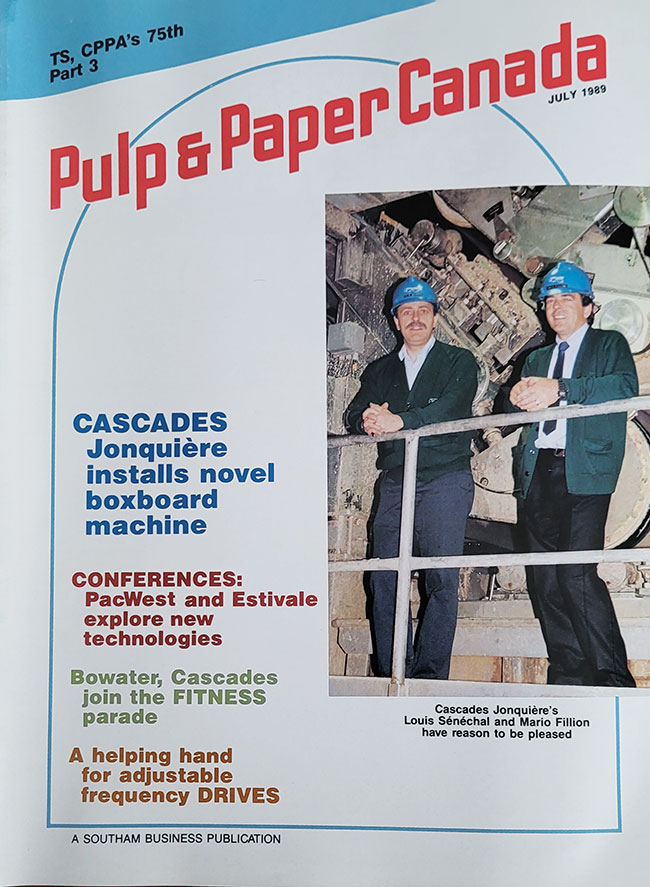
Features
Paper
Pulp
Research & Innovation
Tissue
Water & Chemicals
Voices from the past: Notes from two former editors of Pulp & Paper Canada
April 18, 2023 By P&PC Staff
 A print issue cover of the magazine from 1989
Photo: Cindy Macdonald
A print issue cover of the magazine from 1989
Photo: Cindy Macdonald 
Scott Jamieson
By Scott Jamieson
It was a stroke of luck that I began my B2B media career as an assistant editor on Pulp & Paper Canada in 1991. As an employee at Paprican (now FPInnovations), I attended the once-massive pulp and paper convention in Montreal looking to indulge my love of writing. The first person I met was long-time P&PC editor Peter Williamson, who was looking for a new team member.
Not long after, I was reporting to Peter as part of a dream team. The bulk of my training was at the hands of the thorough and passionate associate editor Sue Stevenson. Much of my early career, I owe to her. I also worked with managing editor Graeme Rodden on the Daily Reporter we handed out to Montreal convention delegates each year, to be slipped under hotel room doors by 6:30 a.m. Some readers will remember these iconic media figures. I certainly do, and fondly. They gave me a foundation that has served me well since.
Soon after I moved on as editor of Canadian Forest Industries, and then part owner of three forestry media brands, and the rest is history. But I remember that early P&PC reporting well. My first feature was on the then-contentious issue of secondary effluent treatment. I interviewed dozens for what I wanted to be a definitive overview of treatment options and tech and took far too long to put it all together (just ask Sue), but it was an example of what trade journalists could accomplish with time, curiosity and the right mentoring.
This was also the first real barrage of environmental concerns. The public wanted – and the industry would soon deliver – action around effluent treatment, recycling, dioxins, clear cutting, forestry certification and more. These were challenging times to be in – and report on – Canada’s pulp and paper sector. Industry executives were getting “pied” by activists in downtown Vancouver, and some young trade journalists were collateral damage. The difference was I only owned the one suit. But the industry, and my wardrobe, persevered.
This was also an exciting era for investment in new mills, mostly out west, and new paper machines and technology, mostly in the east. I was privileged to visit Kruger and Tembec installations for cover stories on cutting-edge papermaking technology, and to interview industry tycoons the likes of which we no longer see.
One highlight was flying with Repap’s George Petty on his private jet to cover his pioneering Alcell bio-refinery in Miramichi, NB. I was a more-than-intimidated college grad on that trip, but I got the job done, despite George’s scowls and implied threats.
We were also key partners of the Canadian Pulp & Paper Association (CPPA) Technical Section back then. We edited, prepared and published the association’s Technical Papers, serious works of engineering over which Sue and Peter presided. This was a privileged role, and they made sure I knew it. Pencil in hand, I did my best to make these dense tomes readable but still technical.
This era also saw dramatic technical changes in the media business. I witnessed the introduction of the first fax machine to our operations, technical wizardry that cut proofing time by weeks. Prior to that, they were…yes, mailed to authors. I also introduced the first spell-checking software to the operation, despite serious doubts among older colleagues. Finally, we moved from manual cut-and-paste to desk-top publishing.
But in all of this, one thing never changed. The immense responsibility of caring for a piece of Canada’s magazine history, a brand covering one of our country’s primary industries. The weight of 120 years of continual publication should weigh heavy on any editor. Sorry, Sukanya. But also, you’re welcome.
My old bosses would not recognize the media landscape that P&PC inhabits. But the core job remains the same – To provide niche information and a like-minded community for all that serve this tenacious industry.
Thank you for reading – then, now and in the years to come.
Scott Jamieson is the president and chief operating officer of Annex Business Media, publishers of 60 B2B media brands, and the founding editor of Canadian Biomass.

Cindy Macdonald
By Cindy Macdonald
Recently, a sponsored post from an environmental activist group showed up in my Twitter feed accusing Procter & Gamble of cutting down old growth trees for toilet paper. My responses were, in order: Really? Again? Still?
I’ve been involved with the pulp and paper industry off and on for almost 30 years. This public relations battle has been going on that whole time, and long before. I joined Pulp & Paper Canada just before the war in the woods, during the dioxin years in the late-80s.
At that time, the industry was being asked to control a carcinogen that had just begun to show up in testing. And we did, quickly.
Then, in no particular order, the environmental activists came after the forestry sector for logging old growth forests, various endangered species, wastewater, caribou and the Boreal forest. This industry has made tremendous gains in sustainable development, but there will always be some trade-offs between industrial development and the natural world, and someone ready to criticize our choices.
What struck me about the pulp and paper sector, even as a journalism student when I first joined Pulp & Paper Canada, was the open sharing of information. The technical papers and the conferences were quite astonishing. I have not seen the same degree of cooperation in any other industry I’ve covered: automotive repair, plastic part manufacturing, construction, engineering, retail. It’s something this industry should be proud of.
Speaking of technical papers, when I started with Pulp & Paper Canada, Sue Stevenson managed that task. The magazine was the Journal of Record for the CPPA Technical Section. She used file folders stapled together accordion style to track the status of available papers, noting when they were edited, peer-reviewed, approved by the author, and ready for publication. It was a hand-written, paper-based spreadsheet that worked flawlessly.
Eventually, Pulp & Paper Canada stopped publishing technical papers when it became easier and more common to publish such work online. This decision was made several years after I rejoined Pulp & Paper Canada as editor in 2009.
A major shift was happening during my tenure from 2009 to 2016. Biofuels, bioproducts, bioenergy were beginning to gain traction. These represented a new revenue stream for Canada’s pulp and paper industry to explore.
Driven by extraordinary individuals, Canada’s pulp and paper companies have been adaptable, innovative and resourceful. I have no doubt this sector will thrive for many more years to come.
Cindy Macdonald is a former editor of Pulp & Paper Canada (2009 to 2016)
Print this page